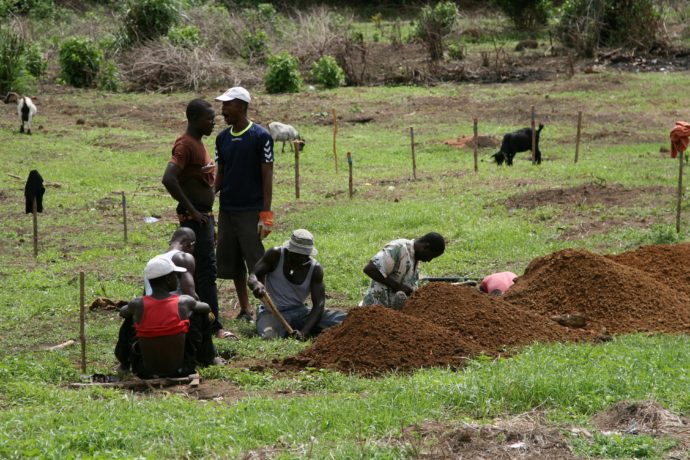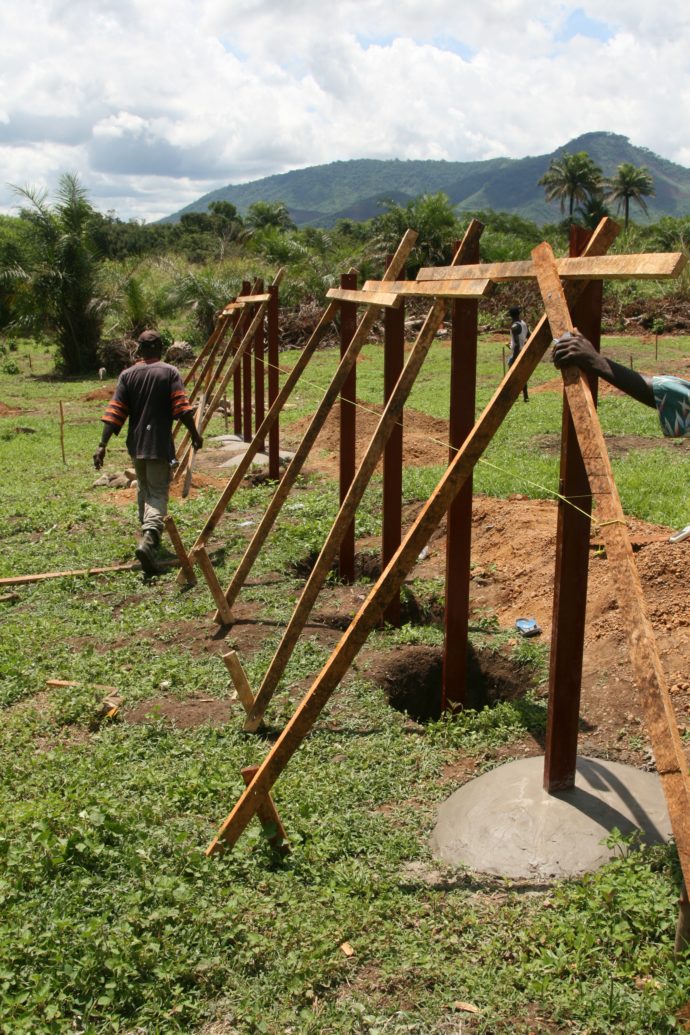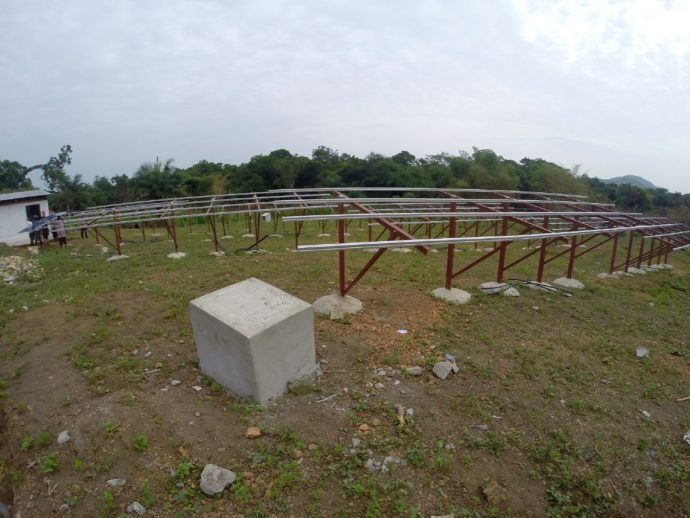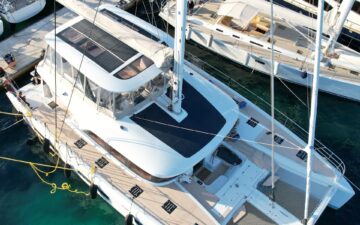
Masanga Hospital, Tonkolili District
Coordinates: 8°44’56.3″N 11°50’17.8″W
The Masanga Hospital Rehabilitation Project (MHRP) is in Sierra Leone. The project has been driven by the Danish voluntary organisation Masanga DK, with the hospital solar system itself having been built by Thorbjørn Villesen of ABK Solar Tech and an on-site trained Sierra Leonean team.
System facts at a glance
The solar system supplies power to all of the hospital wards, laboratory, and health staff living quarters.
- System type: Off-grid + Minigrid
- Electricity output: 3 phase, 70kW (continuous), 140kW (peak)
- 6 x Quattro 48/8000
- Solar capacity: 35 kWp
- 6 x MPPT 150/85 solar charge controllers
- Battery capacity: 120 kWh (wet type solar batteries)
- In operation since: July 2015
- Estimated power produced to date: 52,000 kWh
About the solar system
It was a long-standing wish for MHRP to become a carbon neutral hospital by having as little a negative impact on the surrounding environment. Since the hospital is completely cut off from the sparse national grid, it was previously completely dependent on costly power from diesel generators.
With this in mind Thorbjørn Villesen, Danish energy Engineer and PhD in sustainable energy solutions (now owns and runs the company ABK Solar Tech in Freetown) started fundraising for the establishment of a large solar system for Masanga in 2012. With the help of two large donors, the project was started in 2014 but was then prematurely put on hold due to the Ebola outbreak sweeping across the country. In 2015 the solar system was finally finished and has since been powering the hospital 24/7.
The solar system was built with minimal resources.
Foundations were dug by hand.
Sand for the foundations was sourced at the local river.
Mounting racks were built from scratch.
A makeshift concrete shed was constructed to hold the batteries and inverters and is shown in this blog headline image. Double metal sheet roofing effectively keeps out the fierce heat, and passive circulation efficiently keeps the temperature low in the battery house.
The solar system is an off-grid 35 kWp solar park, with 6 Victron MPPT 150/85 solar chargers and an AC coupled Fronius Symo 10.0-3-M grid inverter. The 120 kWh wet battery provides power for the smaller standby needs of the hospital through the night. 6 Victron Quattro 48/8000/110 inverters are set up for three-phase parallel operation and provide plenty of power to cover even the peak loads of the hospital’s autoclaves and waste disposal units. The original generators are used for emergency backup and controlled automatically by the Victron Color Control GX and BMW-702.
The solar system is amongst the 5 largest solar systems currently installed in Sierra Leone.
Project background
MHRP is an agreement between two European NGOs (Masanga DK and Sierra Leonean Adventists Abroad) and the Sierra Leonean Ministry of Health and Sanitation (MoHS), which was established in 2006 to rehabilitate and manage Masanga Hospital for a twenty-year consecutive period. Today, three other NGOs (CapaCare, Masanga UK and Masanga NL) support the original organisations with running costs and expertise.
MHRP is a three-legged project which comprises the provision of health care services in the rural district of Tonikolilli, health care education and entrepreneurship. As such the medical diagnostics and treatments provided at the hospital serve as a teaching platform for the many students enrolled at the facility. Businesses within the project are gathered under the umbrella of Masanga Hospital Sustainability Enterprises and are established within the project to create local growth, jobs and development as well as co-financing the project activities.
MHRP’s mission is to manage the hospital and to support the transformation of this former leprosy hospital into a governmental medical training centre of excellence, with a strong focus on surgical and nursing capacity building. The intention and exit strategy is to hand over a well-functioning facility to the Ministry of Health and Sanitation that is self-sustaining and has essential spearhead functions which will guarantee its continued necessity and existence, after the change of management.
Masanga hospital
In 1964 the Government of Sierra Leone established Masanga Leprosy hospital in Tonkolili District. Soon after opening, the hospital developed an international reputation for treating Leprosy; it owes its isolated jungle location partly to the fear that leprosy could engender half a century ago. Until 1997 the Seven Day Adventist Church ran the hospital as Leprosy institute.
During the civil unrest, the hospital was occupied and heavily damaged by the rebels. In 2006 the hospital re-opened with the support of the Danish organisation, Association Friends of Masanga (AFOM) and the English based Sierra Leonean Adventists Abroad (SLAA). The two organisations signed a memorandum of understanding (MoU) with the GoSL on Thursday the 13th July 2006. In the MoU both NGO’s were held responsible to rehabilitate and manage Masanga Hospital. Since then, permanent and rotating staff – both national and expatriate – have been working to do exactly this.
Since 2006 Masanga Hospital has provided medical care for nearly 300,000 patients. The former leprosy health facility has now been transformed into a 100-bed general hospital and established itself as a teaching platform to build the medical expertise of health care workers.
Tonkolilli District College of Health Sciences
The attached college, Tonkolili District College of Health Sciences (TDCHS), has enrolled nearly 300 State Enrolled Community Health Nurse (SECHN) students since the opening in 2012 and the first class graduation in October 2015. Furthermore, Masanga Hospital provides the first six months of Norwegian’s CapaCare two years task shift training program of medical doctors and community health officers (CHO’s) into surgically trained CHO’s. Masanga Hospital is the main training site for this innovative, highly needed – and rewarding – surgical training program.
Currently, TDCHS is developing the first national curriculum for training physiotherapists. It is also the ambition to train State Registered Nurses, midwives, lab technicians and hospital administrators.
Masanga Hospital Sustainability Enterprises
Masanga Hospital Sustainability Enterprises comprises of a bike shop, a tailor shop, a piggery and agriculture. These enterprises form alliances with foreign partners and product from the tailor shop are sold in Europe as fair trade. Besides creating jobs locally, the surplus generated by MHSE co-finances the running costs of the hospital.
Conclusion
It’s always great to be associated with laudable professional projects such as this.
Thanks to Niels Kaarill, who is the Victron area sales manager for Scandinavia, for making me aware of this project. Thanks also to the enchantingly nicknamed ‘Professor Solar’ (Thorbjørn Villesen of ABK Solar Tech) for the images and information used in this blog. And lastly and not least Masanga DK, without whom this project would not have even got started.
John Rushworth
Project link:
Masanga DK – http://www.masanga.dk






















 #victronenergy #adventure
#victronenergy #adventure
 ELECTRICS
ELECTRICS 
